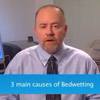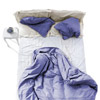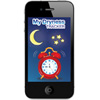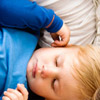Nocturnal enuresis in teens: a neglected problem
Bedwetting or nocturnal enuresis (NE; nocturnal meaning night and enuresis meaning involuntary urination) can be a distressing disorder that carries a significant burden for the affected person and their family. It is defined as intermittent episodes of incontinence while sleeping (at least twice a week) and applies to persons over the age at which bladder control is attained, typically five years of age or older.
In many teenagers with NE, the condition can significantly impact on their social life and self-esteem. As many as 20% of enuretic teens have never seen a doctor about this issue and up to 40% have received no therapy. If left untreated, nocturnal enuresis may continue into adulthood for at least 5-10% of those affected. This can be distressing for the individual and their family, which is unnecessary given that treatment is effective in most cases.
Nocturnal Enuresis
The incidence of NE decreases with increasing age such that in the younger age groups it is quite common and can affect approximately 20% of 5 year olds compared to only 3.8% of children aged 6-14 years old. Fortunately, most of these children will outgrow bedwetting, but for some it can persist into adulthood. Many parents don’t realise NE is largely treatable. In children aged 5-12 years who wet the bed, only 1 in 3 are taken to see the doctor.
If a child has never been dry at night, this is called primary nocturnal enuresis. If a child has previously had a period of at least six months of being dry at night and has then recommenced bedwetting, the enuresis is said to be secondary.
 | For more information about the causes of bed wetting view the video: Causes of Bedwetting. |
Bedwetting can be further classified based on whether or not the bedwetting occurs with or without lower urinary tract symptoms:
- Monosymptomatic nocturnal enuresis (MNE) is bedwetting in children without any other urinary tract symptoms or history of bladder problems.
- Non-monosymptomatic nocturnal enuresis (NMNE) is enuresis (involuntary urination) which has symptoms in addition to night-time bedwetting such as daytime wetting, urinating frequently during the day and often feeling an urgent need to urinate.
 | For more information about what causes nocturnal enuresis and how it can be treated, see Nocturnal Enuresis (Bed Wetting). |
Impacts of bedwetting on the teenager
Enuresis can be a distressing disorder for both parent and child. Children and teenagers affected by enuresis report negative effects on self-perception (how they view themselves), reduced self esteem, interpersonal behaviour and quality of life. As such, they may experience loss of confidence, difficulty making friends and underachieving at school. As age increases into adolescence and adult years, there may be reluctance to stay away overnight, may complicate relationships and may have a major influence in their life.
Parents of children affected by NE have reported feelings of anxiety, guilt and loss of confidence in their parenting skills.
The treatments
First-line therapy for bedwetting is usually an enuresis alarm. Alarm therapy works by waking the person at the exact moment when wetting begins. This therapy improves arousal from sleep, and helps to alert and sensitise the person to respond to a full bladder during sleep.
There are two types of alarms available:
- Pad and Bell Alarm: the pad goes on the bed and is connected to an alarm or bell that rings when the pad gets wet.
- Body-worn Alarm: this clips onto the child’s underpants.
It’s generally recommended that alarm therapy be continued for at least two to three months, or until they achieve 14 consecutive dry nights.
There are also medications available to treat bedwetting. One of them has an active ingredient called desmopressin. It works like vasopressin which is a naturally-occurring substance produced in the brain. For children who wet the bed as a result of low levels of vasopressin during the night, desmopressin supplements the body’s natural vasopressin, thus reducing the amount of urine produced during the night.
Oxybutynin is an anticholinergic medication and may be used if a person has an overactive bladder during sleep. Tricyclic antidepressants such as imipramine, are also used for the treatment of bedwetting. However, they are less commonly recommended because of their potential side-effects.
You may also hear about other treatments that are less commonly used such as hypnosis, acupuncture, psychotherapy, reward systems and fluid restriction. It has not been established whether these treatments are effective in managing bedwetting.
There are Apps available for smart phones and tablets that help self-reporting and facilitate better communication with Healthcare Professionals about bedwetting habits. Perth GP Dr Joe Kosterich said the “My Dryness Tracker” App is a useful way for doctors to gain insights into a child’s bedwetting patterns.
Features of the My Dryness Tracker App include:
- Bedwetting checklist;
- Day-time and night-time voiding diaries;
- Treatment progress trackers;
- Enuresis alarm ordering facility; and
- Treatment progress reports.
 | Click here for more information on the My Dryness Tracker App. |
Kindly written and reviewed by Dr Allison Johns Bsc (Hons) MBBS, Doctor at Child and Adolescent Health Services and Editorial Advisory Board Member of Virtual Medical Centre.
More information
 | For more information about bed wetting including lifestyle advice, how the urinary system works and much more, see Bed Wetting (Nocturnal Enuresis). |
References
- Nappo et al (2002) Nocturnal enuresis in the adolescent: a neglected problem. BJU International. 90; 912-917 [Abstract]
- Schulpen TW. The burden of nocturnal enuresis. Acta Paediatr. 1997;86(9):981-4. [Abstract]
- Nørgaard JP, Djurhuus JC, Watanabe H, et al. Experience and current status of research into the pathophysiology of nocturnal enuresis. Br J Urol. 1997;79(6):825-35. [Citation]
- Kuehhas FE, Djakovic N, Hohenfellner M. Infantile enuresis: Current state-of-the-art therapy and future trends. Rev Urol. 2011;13(1):1-5. [Full Text]
- Caldwell PH, Edgar D, Hodson E, Craig JC. Bedwetting and toileting problems in children. Med J Aust. 2005;182(4):190-5. [Abstract]
- Caldwell PH, Ng C. Management of childhood enuresis. Medicine Today. 2008:9(8):16-24.
- Butler RJ. Annotation: night wetting in children: psychological aspects. J Child Psychol Psychiatry 1998; 39 : 453–63 [Citation]
- Hagglof B, Andren O, Bergstrom E, Marklund L, Wendelius M. Self-esteem in children with nocturnal enuresis and urinary incontinence: improvement of self-esteem after treatment. Eur Urol 1998; 33 (Suppl. 3): 16–9. [Abstract]
- Bower WF, Moore KH, Shepherd RB, Adams RD. The epidemiology of childhood enuresis in Australia. Br J Urol. 199;78(4):602-6
- Nevéus T, von Gontard A, Hoebeke P, et al. The standardization of terminology of lower urinary tract function in children and adolescents: Report from the Standardisation Committee of the International Children’s Continence Society. J Urol. 2006;176(1):314-24. [Abstract]
- Glazener CM, Evans JH, Peto RE. Alarm interventions for nocturnal enuresis in children. Cochrane Database Syst Rev. 2009:CD002911. [Abstract | Full text]
- Nevéus T. Nocturnal enuresis: Theoretic background and practical guidelines. Pediatr Nephrol. 2011;26(8):1207-14. [Full Text]
- Van de Walle J, Van Herzeele C, Raes A. Is there still a role for desmopressin in children with primary monosymptomatic nocturnal enuresis?: A focus on safety issues. Drug Saf. 2010;33(4):261-71. [Abstract]
- Neveus T, Eggert P, Evans J, et al. Evaluation of and treatment for monosymptomatic enuresis: A standardization document from the International Children’s Continence Society. J Urol. 2010;183(2):441-7. [Abstract]
Dates
Tags
Created by:

 Login
Login














